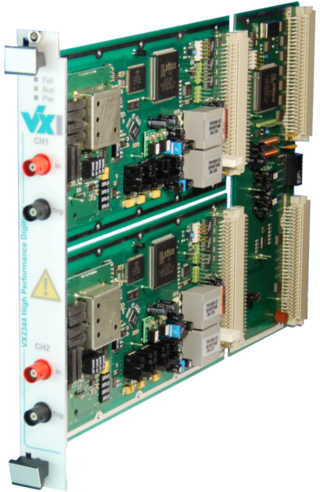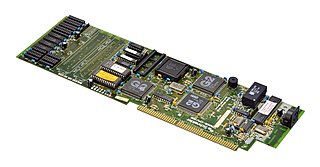
Eurocard is an IEEE standard format for printed circuit board (PCB) cards that can be plugged together into a standard chassis which, in turn, can be mounted in a 19-inch rack. The chassis consists of a series of slotted card guides on the top and bottom, into which the cards are slid so they stand on end, like books on a shelf. At the spine of each card is one or more connectors which plug into mating connectors on a backplane that closes the rear of the chassis.

A logic analyzer is an electronic instrument that captures and displays multiple logic signals from a digital system or digital circuit. A logic analyzer may convert the captured data into timing diagrams, protocol decodes, state machine traces, opcodes, or may correlate opcodes with source-level software. Logic analyzers have advanced triggering capabilities, and are useful when a user needs to see the timing relationships between many signals in a digital system.

In computing, an expansion card is a printed circuit board that can be inserted into an electrical connector, or expansion slot on a computer's motherboard to add functionality to a computer system. Sometimes the design of the computer's case and motherboard involves placing most of these slots onto a separate, removable card. Typically such cards are referred to as a riser card in part because they project upward from the board and allow expansion cards to be placed above and parallel to the motherboard.

IEEE 488, also known as HP-IB and generically as GPIB, is a short-range digital communications 8-bit parallel multi-master interface bus specification developed by Hewlett-Packard. It subsequently became the subject of several standards.

Agilent Technologies, Inc. is an American global company headquartered in Santa Clara, California, that provides instruments, software, services, and consumables for laboratories. Agilent was established in 1999 as a spin-off from Hewlett-Packard. The resulting IPO of Agilent stock was the largest in the history of Silicon Valley at the time. From 1999 to 2014, the company produced optics, semiconductors, EDA software and test and measurement equipment for electronics; that division was spun off to form Keysight. Since then, the company has continued to expand into pharmaceutical, diagnostics & clinical, and academia & government (research) markets.

A single-board computer (SBC) is a complete computer built on a single circuit board, with microprocessor(s), memory, input/output (I/O) and other features required of a functional computer. Single-board computers are commonly made as demonstration or development systems, for educational systems, or for use as embedded computer controllers. Many types of home computers or portable computers integrate all their functions onto a single printed circuit board.

Electronic test equipment is used to create signals and capture responses from electronic devices under test (DUTs). In this way, the proper operation of the DUT can be proven or faults in the device can be traced. Use of electronic test equipment is essential to any serious work on electronics systems.
LAN eXtensions for Instrumentation (LXI) is a standard which defines the communication protocols for instrumentation and data acquisition systems using Ethernet.

National Instruments Corporation, doing business as NI, is an American multinational company with international operation. Headquartered in Austin, Texas, it is a producer of automated test equipment and virtual instrumentation software. Common applications include data acquisition, instrument control and machine vision. Since October 2023, NI operates as Emerson Electric's test and measurement business unit after getting acquired.

VME eXtensions for instrumentation bus refers to standards for automated test based upon VMEbus. VXI defines additional bus lines for timing and triggering as well as mechanical requirements and standard protocols for configuration, message-based communication, multi-chassis extension, and other features. In 2004, the 2eVME extension was added to the VXI bus specification, giving it a maximum data rate of 160 MB/s.

Automatic test equipment or automated test equipment (ATE) is any apparatus that performs tests on a device, known as the device under test (DUT), equipment under test (EUT) or unit under test (UUT), using automation to quickly perform measurements and evaluate the test results. An ATE can be a simple computer-controlled digital multimeter, or a complicated system containing dozens of complex test instruments capable of automatically testing and diagnosing faults in sophisticated electronic packaged parts or on wafer testing, including system on chips and integrated circuits.
Keysight VEE is a graphical dataflow programming software development environment from Keysight Technologies for automated test, measurement, data analysis and reporting. VEE originally stood for Visual Engineering Environment and developed by HP designated as HP VEE; it has since been officially renamed to Keysight VEE. Keysight VEE has been widely used in various industries, serving the entire stage of a product lifecycle, from design, validation to manufacturing. It is optimized in instrument control and automation with test and measurement devices such as data acquisition instruments like digital voltmeters and oscilloscopes, and source devices like signal generators and programmable power supplies.
Instrument control consists of connecting a desktop instrument to a computer and taking measurements.

A CPU card is a printed circuit board (PCB) that contains the central processing unit (CPU) of a computer. CPU cards are specified by CPU clock frequency and bus type as well as other features and applications built into the card.
PathWave Design is a division of Keysight Technologies that was formerly called EEsof. It is a provider of electronic design automation (EDA) software that helps engineers design products such as cellular phones, wireless networks, radar, satellite communications systems, and high-speed digital wireline infrastructure. Applications include electronic system level (ESL), high-speed digital, RF-Mixed signal, device modeling, RF and Microwave design for commercial wireless, aerospace, and defense markets.
A digital pattern generator is a piece of electronic test equipment or software used to generate digital electronic stimuli. Digital electronics stimuli are a specific kind of electrical waveform varying between two conventional voltages that correspond to two logic states. The main purpose of a digital pattern generator is to stimulate the inputs of a digital electronic device. For that reason, the voltage levels generated by a digital pattern generator are often compatible with digital electronics I/O standards – TTL, LVTTL, LVCMOS and LVDS, for instance.
M-Modules are a mezzanine standard mainly used in industrial computers. Being mezzanines, they are always plugged on a carrier printed circuit board (PCB) that supports this format. The modules communicate with their carrier over a dedicated bus, and can have all kinds of special functions.
AdvancedTCA Extensions for Instrumentation and Test (AXIe) is a modular instrumentation standard created by Aeroflex, Keysight Technologies, and Test Evolution Corporation. (In October 2008, Aeroflex had purchased a 40% shareholding in Test Evolution.)
An instrument driver, in the context of test and measurement (T&M) application development, is a set of software routines that simplifies remote instrument control. Instrument drivers are specified by the IVI Foundation and define an I/O abstraction layer using the virtual instrument software architecture (VISA). The VISA hardware abstraction layer provides an interface-independent communication channel to T&M instruments. The drivers encapsulate the Standard Commands for Programmable Instruments (SCPI) commands, which are an ASCII-based set of commands for reading and writing instrument settings and measurement data. This standard allows an abstract way of using various programming languages to program remote-control applications instead of using SCPI commands. An instrument driver usually has a well-defined API.

CompactDAQ is a data acquisition platform built by National Instruments that includes a broad set of compatible hardware and software. CompactDAQ integrates hardware for data I/O with LabVIEW software to enable engineers to collect, process and analyse sensor data. CompactDAQ systems are less expensive than equivalent systems within the NI PXI Platform.













